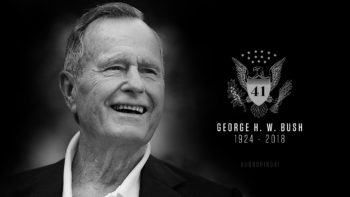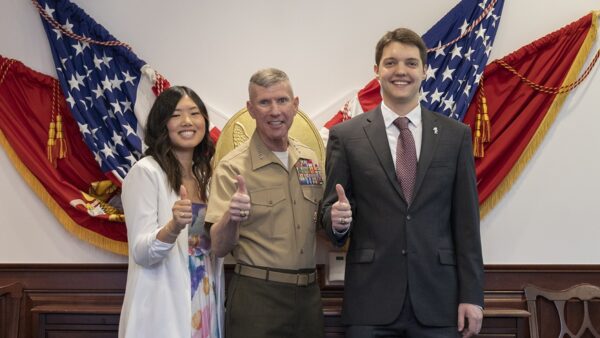George H. W. Bush’s extraordinary relationship with Texas A&M University has produced a generation of public servants who graduated from the Bush School of Government and Public Service before securing positions across local, state and national government organizations.
Meanwhile, more than 1 million people from around the world have studied Bush’s life and legacy while touring the presidential library and museum dedicated to telling his story.
A sculpture between the two buildings honors the namesake of the school and museum, demanding attention from passersby with a distinguished pose.
Hundreds of people daily pass the bronze on the way to class or to the museum — some to receive an education in public service, others to learn about the immeasurable contributions the 41st president made. As the names, faces and places of origin change over the years, the larger-than-life depiction of the former president stoically gazes westward, eyes fixated beyond the Texas horizon, as a physical anchor to the spirit of public service that the two buildings embody.
Soon, more people will become familiar with the statue as they make their way to a new destination near the reflection pond, over a bridge through a wooded creek bed, to his final resting place.
President George H.W. Bush passed away Friday, Nov. 30 at the age of 94, the longest living president in the history of the United States.
He will be buried Thursday, Dec. 6 on the George H.W. Bush Library and Museum grounds at Texas A&M University alongside his wife and former First Lady Barbara Bush, who passed away in April, and their daughter Robin, who passed away at age 3 after suffering from leukemia.
The man who inspired generations of Americans by living his guiding principle of “public service as a noble calling” is no longer physically present to spread his message, but just as the statue stands tall immune to the passing of time, Bush’s spirit of selflessness and dedication to public service will carry on at Texas A&M.“He truly has a lifetime of service and I think that matches wonderfully well with what the essence of this university is all about,” Texas A&M University President Michael K. Young* said. “The opportunity and the privilege of a great education is to use it on behalf of others, and he certainly emblemizes a life of service on behalf of others.”
Selfless-service
Bush’s life of public service began in World War II when at the age of 18 he became the youngest pilot in Navy history, flying 58 combat missions as a torpedo bomber. In 1944 his plane was attacked by Japanese antiaircraft during a bombing mission of Chi Chi Jima, but he completed the run before ejecting. Three of Bush’s crew members died in the attack, but his bravery earned him a Distinguished Flying Cross. He would recover from his injuries and continue to fly successful missions until his honorable discharge in 1945 after Japan’s surrender.
He returned to civilian life, married Barbara Pierce and enrolled in Yale where he was a standout academic and baseball star before trying his hand in the West Texas oil fields.
While in Texas he was drawn to a life of public service and politics and served two terms in the U.S. House of Representatives. Although his two campaigns for Senate were unsuccessful, he was appointed as the U.S. Ambassador to the United Nations, Chairman of the Republican National Committee, Chief of the U.S. Liaison Office in the People’s Republic of China and the director of the CIA.
In 1980, he was selected as a running mate by President Ronald Reagan. After two terms as vice president under Reagan, he successfully won the presidency in 1988.
As president he oversaw the collapse of the Berlin Wall, secured Kuwait’s independence in the Gulf War and passed the Americans with Disabilities Act (ADA) among many other achievements. He would unsuccessfully run for reelection in 1992, but formed a close bond with successor Bill Clinton years later through humanitarian efforts, most recently, the One America Appeal, which raised $42 million in 2017 for hurricane victims.
The fundraising effort included the One America Appeal concert on Texas A&M’s campus, where Bush and Clinton were joined by former Presidents Jimmy Carter, George W. Bush and Barack Obama in their call for storm relief.
“First of all, I am thrilled to be able to introduce 39, 42 and 44 to one of the finest universities in the United States. I, too, am here to urge you to give to this fine fund and I want to thank all the volunteers, but I am here for another reason,” the younger Bush said during the concert, looking at his family in the front row of the audience. “We really love and admire George H.W. Bush.”
Former President Obama echoed the younger Bush’s sentiment, referring to the elder Bush as “an outstanding American, someone who has always shown grace and character and courage and served America nobly throughout the years.”
Preserving a legacy
President Bush’s first major interactions with Texas A&M came in the ‘80s when he delivered commencement ceremony speeches while serving as Vice President. He became enamored with Texas A&M’s commitment to service and military history through the Corps of Cadets, and returned to campus in May 1989 as President to deliver another commencement address that would double as the platform for his first major foreign policy speech since taking office.
“We are reminded that no generation can escape history. Parents, we share a fervent desire for our children and their children to know a better world, a safer world. And students, your parents and grandparents have lived through a world war and helped America to rebuild the world,” he said during his commencement remarks. “They witnessed the drama of postwar nations divided by Soviet subversion and force, but sustained by an allied response most vividly seen in the Berlin airlift. And today I would like to use this joyous and solemn occasion to speak to you and to the rest of the country about our relations with the Soviet Union. It is fitting that these remarks be made here at Texas A&M University.”
Behind the scenes, Texas A&M former student, oil tycoon and longtime friend of George H.W. Bush, Michel Halbouty, took advantage of the small amount of time President Bush had on campus to hand-deliver a formal proposal that outlined Texas A&M’s vision for a presidential library and museum.
Bush’s alma mater Yale and Texas universities Houston and Rice also expressed interest in housing a library and museum, but the prospect of an accompanying school of government set Texas A&M apart from the competition.
“I thought Texas A&M was really remarkably brilliant in their bid for the presidential library,” Bush School Founding Director Chuck Hermann said. “They had realized that preparing people for careers in public service in government and nonprofits was a real passion of Bush. So in their proposal, they devote almost as many pages to the concept of creating a school and co-locating it with the library as they do the description of the library itself.”
By being the first institution to give Bush a proposal, Hermann said Texas A&M became the standard by which all other proposals were compared.
After several meetings at the White House between Bush, his staff and a Texas A&M delegation, Bush told the Texas A&M’s Board of Regents in May 1991 that Texas A&M was his and Barbara Bush’s choice.
Fundraising for the $40 million Bush Presidential Library and Museum and a Bush School of Government and Public Service was underway ahead of its November 1997 open date, but an unexpected loss to Bill Clinton in the 1992 presidential election greatly accelerated the process.
Laying the foundation
Bush Library and Museum Director Warren Finch, who in 1992 was in charge of Bush’s vice presidential records for the National Archives, was detailed to the White House to begin the daunting process of packing up millions of paper records and beginning their transportation to College Station less than a week after Bush’s election loss.
Finch and his team went into White House and Eisenhower Executive Office Building office spaces and carefully filed away Vice Presidential records into paper boxes, one cubic foot in size. He said boxes were stacked on to pallets 30 at a time in the Eisenhower Building before they were loaded onto 21 18-foot tractor trailers and driven to Andrews Air Force Base. From Andrews, the records were flown to Fort Hood where they were driven to College Station and unloaded into a vacant bowling alley by soldiers onto labeled shelves and stored until library construction had been completed. The process was duplicated in January 1993 upon Bush’s departure from office.
The massive logistical effort put into perspective for Finch just how consequential Bush’s career in public life was, and how important it is to preserve it for future generations.
“His life covers a lot of American history, not just the presidency,” Finch said. “It’s our job to make sure that material is available. We are making material available so people can write history.”
Nearly four years after President Bush left office, Finch’s efforts to open a library and museum and Hermann’s efforts to open a school of government and public service came to a head on a picturesque day in 1997 on Texas A&M’s campus.
Duty, honor, country
That crisp Nov. 6 day in 1997 was a historic occasion in which three former presidents and one sitting president came together to celebrate the grand opening of the Bush complex for an audience of Texas A&M administrators, current and former U.S. representatives, celebrities, former vice presidents and former First Ladies. The day also included an invocation from Rev. Billy Graham.
One of the first speakers was then-Texas Governor and future President George W. Bush.
“When President Bush chose Texas A&M University for his library, he made the perfect choice,” the younger Bush said. “This university is a place of tradition, and George Bush is a man of tradition. This university embodies the spirit by which he lived his life: duty, honor and country.”
In addition to George W. Bush, former presidents Jimmy Carter and Gerald Ford also spoke. Among the final speakers was President Bill Clinton, who thanked George H.W. Bush for his service.
“For four-and-a-half years now, even though our relationship began under somewhat unusual circumstances, I have been very grateful that whenever I call on President Bush he was always there with wise counsel and when he agreed, with public support. It’s hard to express to someone who hasn’t experienced it what it means in a moment of difficulty to be able to call someone who first of all knows exactly what you’re up against and secondly tells you the truth, and he has done that time and time again. I am persuaded the country is better off because of it.”
Bush opened his remarks by commenting on the “beautiful Aggie day” before discussing the role of the library on Texas A&M’s campus.
“As to whether we got some things right or could have done some things better, the beautiful thing about this library and the 40 million documents here is that history can make its determination, rendering its judgement based on these documents and other materials safeguarded in this building behind us,” Bush said. “More important to me is how these records will serve to educate future generations of Americans and give them a broader understanding of how their government responded in the way it did to the challenges it faced at a watershed moment in history. Hopefully the insights gained and the impressions left by the events on display here will do for our visitors what they have done for those who lived them: make deeper our appreciation for the blessings of freedom and democracy and make stronger our devotion to them.”
Although the work of opening the complex was complete and its mission clearly stated by its namesake, the task of preserving and carrying on Bush’s legacy in Aggieland was just beginning.
Raising the profile
When the Bush School first opened its doors to graduate students in 1997, it was far from resembling the institution that today ranks as one of the nation’s leading public affairs schools.
His sincere interest in the school’s success is apparent in the Bush School graduating class portraits that line the halls of the building. In each photo, Bush stands smiling among the group of graduates, which increased in size with each passing year until 2015 when his health no longer permitted his attendance.
During the Bush School’s second year, when the school was part of the College of Liberal Arts with two full-time faculty and an enrollment of 22 students, Hermann attended a Bush School advisory meeting with then-Texas A&M President Ray Bowen in Kennebunkport, Maine with the Bush family that would change the course of the school’s history.
“You’re the academics and the decisions you make are ultimately what matters and I respect that. But frankly I’m just a little disappointed that the Bush School seems so invisible, so small,” Bush said, according to Hermann.
It was motivation enough for Texas A&M to secure $2 million in funding through the Texas Legislature to establish the Bush School as its own independent unit within the university with its own dean.
At that point, Hermann stepped down from his role of director and join the Bush School faculty. In 1999, Texas A&M selected former CIA Director Robert M. Gates to serve in an interim capacity until 2001 when he accepted the role of Texas A&M’s 22nd president. The university then selected 42-year Army veteran Lt. Gen. Richard Chilcoat to serve as the Bush School’s first full-time dean. Chilcoat would serve in that capacity until stepping down in 2008 while Gates served the university until 2006 to take the position of U.S. Secretary of Defense.
As the Bush School and its profile grew, so did the list of current and former elected representatives, world leaders, acclaimed academics and influential figures who participated in speaking engagements on Texas A&M’s campus. Former Soviet leader Mikhail Gorbachev, former German Chancellor Helmut Kohl, former British Prime Minister Margaret Thatcher, U.S. Sen. Ted Kennedy, U.S. Rep. Nancy Pelosi and President Barack Obama are a few of the scores of major names who came to campus because of their ties to and admiration for President Bush.
For former Bush School Dean Ambassador Ryan Crocker, who served under Bush and five other presidents over the course of his career, Bush’s ability to host leaders and have them engage with the university was representative of his passion for bipartisanship and public service.
“Our mission was not to groom future politicians. Some would go on to politics, but it was to groom those who would serve the people, and that meant a nonpartisan approach was absolutely key,” Crocker said. “If you’re going in to public service, you must have that mindset.”
Crocker served as dean of the Bush School from 2010 to 2016 and said he takes pride in knowing that the students who were molded by the idea that public service is a noble calling now staff government and non-government agencies at their highest levels.
“He believed that 100 years from now, people would look at the Bush School, and it was from this school that our local, state and federal leaders came generation after generation,” Crocker said. “That is exactly what is happening as I look around.”
Fulfilling a purpose
One of the Texas A&M figures responsible for making Bush’s 100-year vision a reality is current Bush School Dean Gen. Mark A. Welsh III, whose office overlooks Bush’s statue.
Prior to joining Texas A&M, Welsh served as Chief of Staff of the U.S. Air Force from 2012 and admired Bush’s commitment to patriotism, service and decorum, three guiding principles Welsh and Bush lean on as a result of military service.
“The whole reason I’m in this job is because he engaged on those kind of topics,” said Welsh, who had planned on living a quiet life as a grandfather upon leaving the Air Force before being offered the job as dean of the Bush School. “It’s about following the purpose of our namesake, which lines up so well with the principals and the ideals and the things this university stands behind. The core values of the university completely align with what President George H.W. Bush said about public service and that’s why the students come.”
Another leader responsible for preserving and growing the Bush legacy in Aggieland is Texas A&M President Michael K. Young, who worked extensively for the Bush administration on German reunification negotiations and later at the 1992 U.N. Conference on Environment and Development, also known as the Rio de Janeiro Earth Summit, in Rio de Janeiro, Brazil.
On a summer morning when Young and his legal team were sitting by a pool preparing for another day of negotiation discussions, Bush stopped by to thank the team for the work. Young said Bush approached him and asked if he had family back home.
“I said ‘Yes, and I’m in a little bit of trouble, because I missed my daughter’s sixth grade graduation,’” Young said. “I was doing briefings to the news media every day, so I was on T.V. every day. My kids were seeing me, but I wasn’t actually physically home.”
Bush paused, retrieved a note card and wrote a message for Young’s daughter, excusing her father’s absence from the ceremony and expressing how much he appreciated her father’s work.
“My daughter has that framed,” Young said. “That kind of gesture suggests an understanding that in the end, what we do devolves into the impact it makes on people and what it means in their lives. I think more than most public servants, he really had a powerful focus on that.”
After President Bush is laid to rest, thousands of people from across the world will pass the statue and share their own personal stories of the 41st president. Whether the emotions and memories are tied to Bush as a war hero, public servant or a letter writer, his presence will be felt in the years to come as it continues to weave into the fabric of Texas A&M University.
“Our attachment to the Bush name will always bring esteem to this university,” Young said. “The underlying themes that ran through his administration are so consistent with our values: particularly that of service, of a focus on people and making their lives better. This shared ethos will live on at Texas A&M in perpetuity.”
* This link is no longer active and has been removed.




